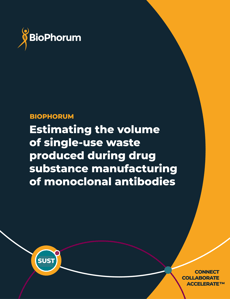Estimating the volume of single-use waste produced during drug substance manufacturing of monoclonal antibodies

Alongside traditional stainless-steel facilities, we see increasing use of single-use technologies (SUTs), which use high-quality plastic systems with numerous complex, interconnected components in the production of biopharmaceuticals.
There are many benefits to this change, e.g., possibly lower production costs, but the growing use of SUTs also results in an increased amount of plastic waste. The complex nature of this waste also poses challenges for recycling.
However, the high-value plastics used in SUTs and the resultant quality of the waste material can offer opportunities, e.g. innovative solutions that may embed circularity in the design of products.
To explore this complex scenario, we have published this paper, which has a particular emphasis on the plastic waste generated.
The first part of the paper considers the case for data sharing and collaboration to enable a better environmental impact of SUTs. It looks at SUT usage and some of the challenges faced when seeking to quantify manufacturing waste material at scale.
The second part provides baseline data that quantifies the single-use plastic waste generated when manufacturing monoclonal antibodies, focusing on batch-level as well as global-level outputs. It incorporates details about the weights of the items used and a variety of process variables.
Various stakeholders – including ESG/SHE leads, waste management specialists, and SUT product designers – can use the data to support decision-making and improve waste management practices.
